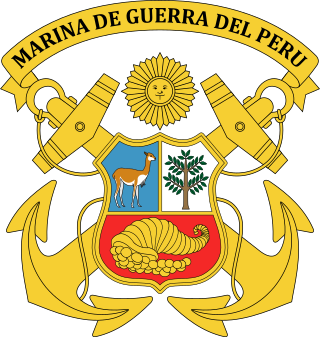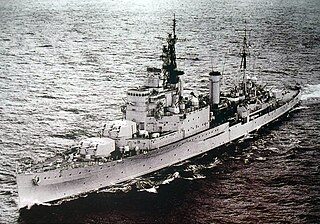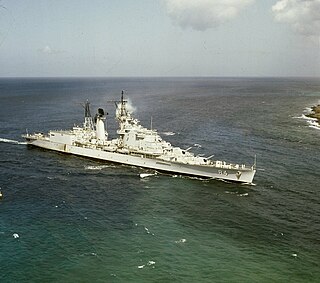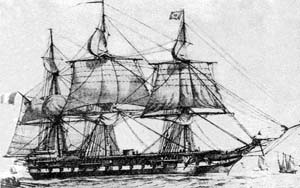
The Peruvian Navy is the branch of the Peruvian Armed Forces tasked with surveillance, patrol and defense on lakes, rivers and the Pacific Ocean up to 200 nautical miles from the Peruvian littoral. Additional missions include assistance in safeguarding internal security, conducting disaster relief operations and participating in international peacekeeping operations.

Huáscar is an ironclad turret ship owned by the Chilean Navy built in 1865 for the Peruvian government. It is named after the 16th-century Inca emperor, Huáscar. She was the flagship of the Peruvian Navy and participated in the Battle of Pacocha and the War of the Pacific of 1879–1883. At the Battle of Angamos, Huáscar, captained by renowned Peruvian naval officer Miguel Grau Seminario, was captured by the Chilean fleet and commissioned into the Chilean Navy.
The Rim of the Pacific Exercise (RIMPAC) is the world's largest international maritime warfare exercise. RIMPAC is held biennially during June and July of even-numbered years from Honolulu, Hawaii, with the exception of 2020 where it was held in August. It is hosted and administered by the United States Navy's Indo-Pacific Command, headquartered at Pearl Harbor, in conjunction with the Marine Corps, the Coast Guard, and Hawaii National Guard forces under the control of the Governor of Hawaii.

The Battle of Angamos was a naval encounter of the War of the Pacific fought between the navies of Chile and Perú at Punta Angamos, on 8 October 1879. The battle was the culminating point of a naval campaign that lasted about five months in which the Chilean Navy had the sole mission of eliminating its Peruvian counterpart. In the struggle, two armored frigates, led by Commodore Galvarino Riveros Cárdenas and Navy Captain Juan José Latorre battered and later captured the Peruvian monitor Huáscar, under Rear Admiral Miguel Grau Seminario.
The flagship of the Peruvian Navy has traditionally borne the name BAP Almirante Grau, in honor of the Peruvian Admiral Miguel Grau Seminario.

BAP Capitán Quiñones (CL-83) was a Fiji-class cruiser in service with the Peruvian Navy. It was completed for the Royal Navy in 1942 as HMS Newfoundland and, after being withdrawn from service, commissioned by the Marina de Guerra del Perú on December 30, 1959. Renamed BAP Almirante Grau (CL-81), in honor of the Peruvian Admiral Miguel Grau, it arrived to its new homeport of Callao on 31 January 1960.

The De Zeven Provinciën class was a class of light cruisers. They were built by Rotterdamsche Droogdok Maatschappij (RDM) and Wilton-Fijenoord for the Royal Netherlands Navy. The name De Zeven Provinciën refers to the seven provinces which formed the Dutch Republic in 1581.

Miguel María Grau Seminario was the most renowned Peruvian naval officer and hero of the naval battle of Angamos during the War of the Pacific (1879–1884). He was known as el Caballero de los Mares for his kind and chivalrous treatment of defeated enemies and is esteemed by both Peruvians and Chileans. He is an iconic figure for the Peruvian Navy, and one of the most famous merchant marine and naval military leaders of the Americas.

The Lupo class is a class of frigates built by Cantieri Navali Riuniti (CNR) for the Italian Navy. Designed as multipurpose warships with an emphasis on anti-surface warfare (ASuW), they have enjoyed some success in the export market, being acquired by the navies of Peru and Venezuela. A small run of a slightly updated version is known as the Soldati class.

BAPAlmirante Grau(CLM-81) was a De Zeven Provinciën-class cruiser that served in the Dutch and Peruvian navies. Completed for the Dutch in 1953 as HNLMS De Ruyter (C801), she was acquired by Peru in 1973 and served as fleet flagship. Almirante Grau underwent a major modernization program between 1985 and 1988 during which she was fitted with new weapons and electronics. She was the last gun cruiser in service in any navy before being decommissioned on 26 September 2017. In 2019, it was to be said that she would be preserved as a museum ship. However, it was later announced on 14 February 2022 that the ship would put up for sale with an asking price of 4,180,000 soles.

BAP Mariátegui is the last out of four Carvajal-class frigates ordered by the Peruvian Navy in 1973. It was built by SIMA at Callao under license from the Italian shipbuilder Cantieri Navali Riuniti. Shortage of funds and technical difficulties delayed her completion for several years, being finally commissioned in 1987. In 1998 her flight deck was extended to allow ASH-3D Sea King helicopters to land and refuel, even though they are too large to be accommodated in the ship's hangar.

BAP Carvajal was the first out of four Carvajal-class frigates ordered by the Peruvian Navy in 1973. It was built by the Italian shipbuilder Cantieri Navali Riuniti at its shipyard in Riva Trigoso, Genoa. Though sea trials were initiated on 9 June 1977 its commissioning was delayed until 23 December 1979 due to delays in equipment deliveries by some subcontractors. In 1998 her flight deck was extended to allow ASH-3D Sea King helicopters to land and refuel, though the hangar is still too small to accommodate them.

BAP Aguirre (CH-84) was a De Zeven Provinciën-class cruiser in service with the Peruvian Navy. It was completed for the Royal Netherlands Navy in 1953 as HNLMS De Zeven Provinciën. After two decades in service, it was decommissioned in August 1976 and sold to Peru. Before being transferred to the Pacific Ocean, it underwent a major rebuild program by Rotterdamse Droogdok Maatschappij (RDM) at its shipyard in Rotterdam. Modifications included the removal of its RIM-2 Terrier SAM system and the installation of a fixed hangar and a flight deck. The upgrade was finished on October 31, 1977 and the ship was commissioned on February 24, 1978 at the Dutch naval base of Den Helder. Renamed Aguirre, in honor of the Peruvian Commander Elías Aguirre, it arrived to its new homeport of Callao on May 17, 1978.

BAP Apurímac was the second steam frigate of the Peruvian Navy, built in England in 1855 along with the steam schooners Loa and Tumbes as a part of a major build-up of the Navy during the government of President José Rufino Echenique. A veteran of two wars and many internal conflicts, due to her age, she served as training ship in Callao port from 1873 until January 17, 1881, when she was scuttled along with the rest of the Peruvian Navy to prevent capture by Chilean troops who had occupied the port after the defeat of the Peruvian Army in the battles of San Juan and Miraflores.

BAP Unión (BEV-161) is a training ship of the Peruvian Navy built between 2012–2015 by Shipyard Marine Industrial Services of Peru, known as SIMA. It is a four-masted, steel-hulled, class "A" barque, composed of 38 steel modules. It has a total length of 115.50 m ; a beam of 13.50 m ; a draft of 6.50 m ; an air draft of 53.50 m ; a displacement of 3,200 tonnes; a speed of 12 knots (22 km/h) and a crew of 250 officers and trainees. The ship's name honors a Peruvian corvette that took part in the first stage of the 1879–1883 War of the Pacific as part of a naval squadron under the command of Miguel Grau, a hero of the Peruvian Navy.

BAP Almirante Grau was a scout cruiser of the Peruvian Navy, the lead ship of its class. Along with its sister ship Coronel Bolognesi, Almirante Grau was one of Peru's two most powerful warships for the first half of the twentieth century. The ship was named for Miguel Grau Seminario, naval hero of the country.

BAP Coronel Bolognesi was a scout cruiser of the Peruvian Navy, the lead ship of its class. Along with its sister ship Almirante Grau, Coronel Bolognesi was one of Peru's two most powerful warships for the first half of the twentieth century. The ship was named for Francisco Bolognesi, a hero of the country for his service in the War of the Pacific.

ROKS Suncheon (PCC-767) was a Pohang-class corvette of the Republic of Korea Navy. It was decommissioned and transferred to the Peruvian Navy as BAP Guise (CC-28).

Manuel José Ferreyros y Senra was a Peruvian naval officer and politician. Ferreyros was a friend and comrade-in-arms of Miguel Grau, Aurelio García and Lizardo Montero, all of whom were known as the Four Aces of the Peruvian Navy. Unlike his comrades-in-arms, Ferreyros did not participate in the War of the Pacific, as he died prematurely, three years before the conflict broke out. His younger brother, Captain Carlos Ferreyros, fought in the war, commanding the Pilcomayo gunboat.

















